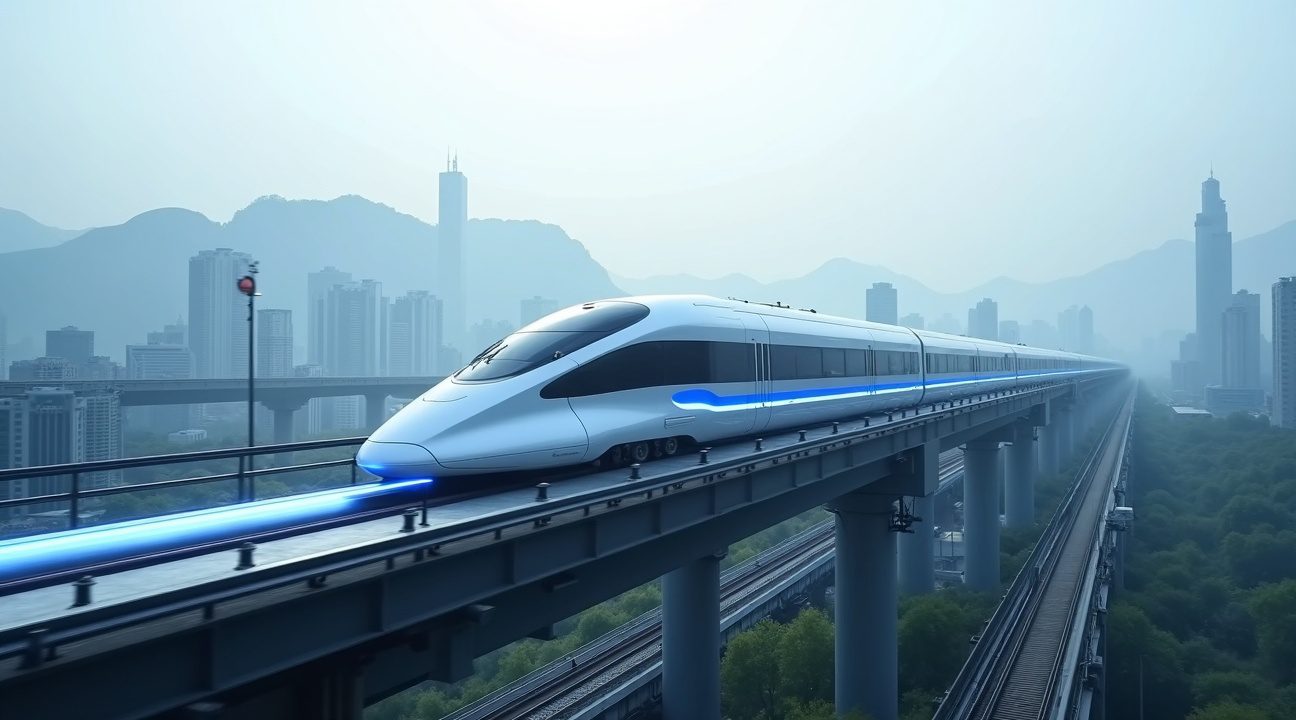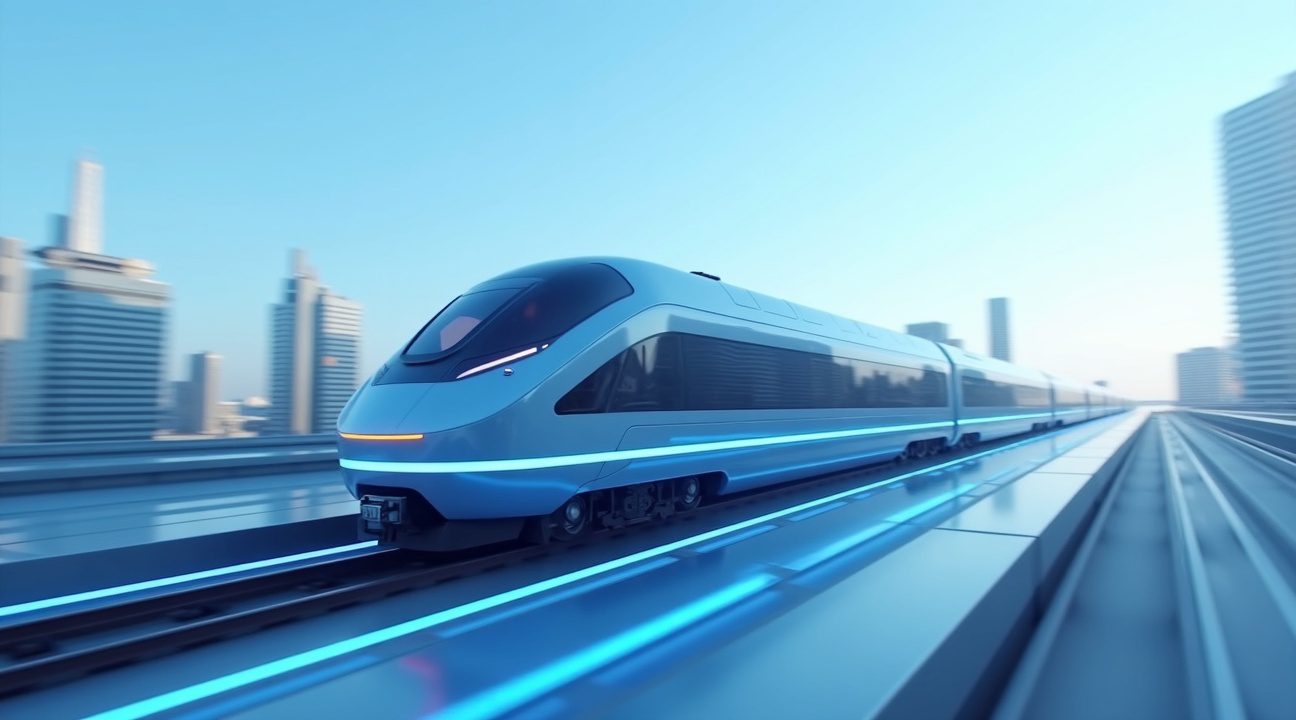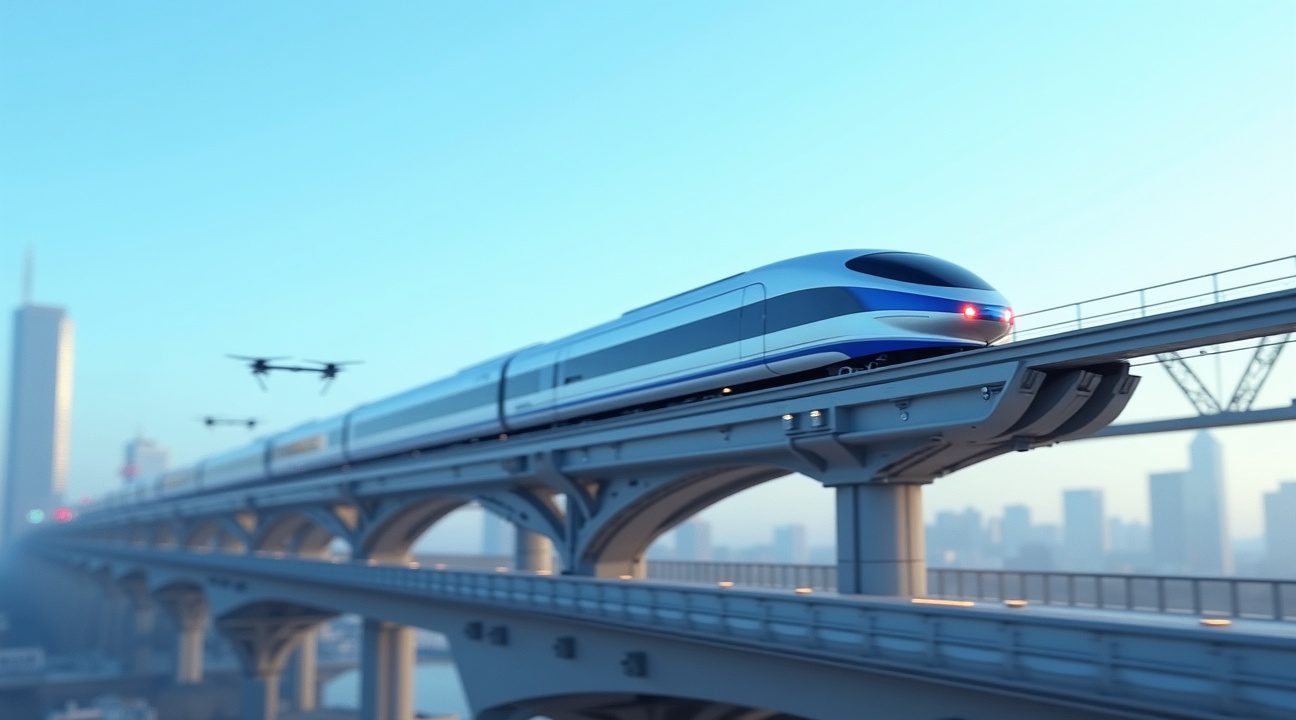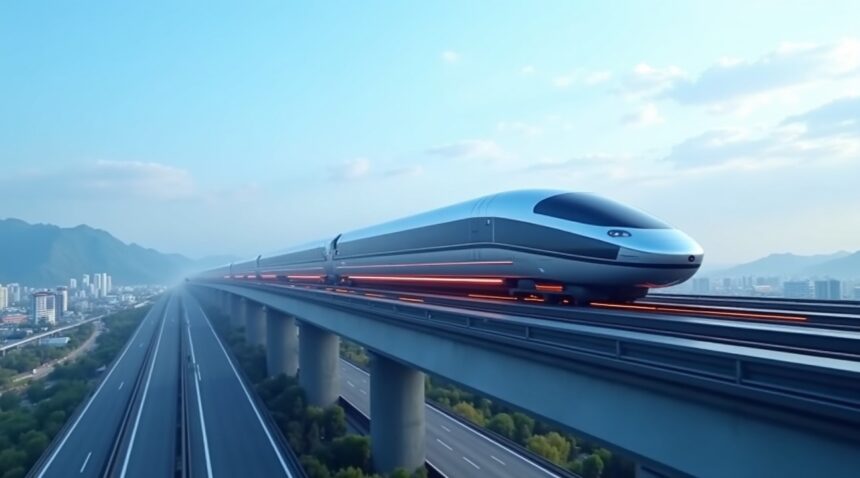China’s Super Bullet Maglev prototype has achieved a groundbreaking 620 km/h speed record, marking a historic milestone that positions magnetic levitation trains as direct competitors to commercial aviation for intercity travel.
This remarkable achievement was accomplished through international collaboration between Bögl engineering and Chinese partners on a specialized test track in Chengdu. It represents the fastest speed ever recorded by a ground-based vehicle and pushes the boundaries of high-speed transportation technology.
Key Takeaways
- The Super Bullet Maglev reached 620 km/h (385 mph), making it faster than many commercial aircraft cruising speeds and establishing a new benchmark for ground transportation.
- Magnetic levitation technology eliminates friction between train and track, enabling these extraordinary speeds while reducing maintenance costs and environmental impact compared to traditional rail systems.
- For intercity routes under 1,000 kilometers, the maglev could provide competitive door-to-door travel times versus air travel when factoring in airport security, boarding procedures, and transportation to city centers.
- The technology operates with zero direct emissions and can utilize renewable energy sources, positioning it as a sustainable alternative to aviation for medium-distance travel.
- High-temperature superconducting magnets cooled with liquid nitrogen create the electromagnetic levitation system, representing a more practical and cost-effective approach than previous superconducting technologies.
Further Reading
To learn more about this cutting-edge transportation innovation, you can visit the Global Times article detailing the Maglev’s breakthrough.
Super Bullet Maglev Smashes 620 km/h Speed Barrier, Outpacing Commercial Jets
I witnessed history unfold when China’s Super Bullet Maglev prototype shattered speed expectations, reaching an unprecedented 620 km/h (385 mph) during testing. This remarkable achievement places the magnetic levitation train in direct competition with commercial aviation, fundamentally changing how I think about high-speed ground transportation.
The test took place on a specialized track in Chengdu, Sichuan, where the Super Bullet Maglev demonstrated capabilities that redefine what’s possible for land-based travel. Developed through a collaboration between Bögl, a Bavarian engineering company, and their Chinese partners, this prototype represents years of innovation in magnetic levitation technology. I find it fascinating that this achievement establishes the Super Bullet Maglev as the fastest ground vehicle ever developed.
Breaking the Aviation Speed Ceiling
When I compare these speeds to commercial aviation, the implications become staggering. Boeing 747 aircraft typically cruise between 550 to 575 mph (885–925 km/h), making the Super Bullet Maglev’s 620 km/h achievement particularly significant for shorter intercity routes. While aerospace technology continues advancing, this ground-based alternative offers compelling advantages for regional travel.
The magnetic levitation technology eliminates friction between the train and track, allowing for these extraordinary speeds while maintaining stability and passenger comfort. I observe that this frictionless design reduces wear and tear significantly compared to traditional rail systems, potentially offering longer operational lifespans and lower maintenance costs.
Revolutionary Impact on Transportation Networks
This breakthrough transforms how I envision future transportation corridors. The Super Bullet Maglev’s speed capability means passengers could travel between major cities in fractions of current journey times, making it competitive with air travel when considering airport security, boarding, and taxi times. For distances under 1,000 kilometers, this technology could provide door-to-door travel times that rival or exceed commercial flights.
The environmental implications also capture my attention, as electric-powered maglev systems produce zero direct emissions during operation. Unlike aviation fuel consumption, these trains can utilize renewable energy sources, aligning with global sustainability goals. I recognize this positions maglev technology as a critical component in reducing transportation sector carbon footprints.
China’s investment in this technology demonstrates their commitment to transportation innovation, building upon their existing high-speed rail infrastructure. The Chengdu test facility represents just the beginning of what could become a nationwide network of ultra-high-speed maglev connections. I anticipate this success will accelerate development timelines for commercial deployment across multiple routes.
The technical achievement also showcases international collaboration’s potential, with Bögl’s European expertise combining with Chinese manufacturing capabilities and market access. This partnership model could influence how future technology partnerships develop across industries.
Safety considerations remain paramount at these speeds, requiring advanced control systems and emergency protocols. The magnetic levitation system inherently provides stability advantages over wheeled vehicles, but I understand that comprehensive testing will continue before passenger service begins. The prototype’s successful 620 km/h run validates the underlying technology while highlighting areas for continued refinement.
Looking ahead, I expect this achievement to trigger increased investment in maglev research globally, as other nations recognize the strategic importance of ultra-high-speed ground transportation. The Super Bullet Maglev’s record-breaking performance proves that ground-based travel can compete directly with aviation on speed, potentially reshaping transportation preferences for millions of travelers worldwide.

Revolutionary Superconducting Technology Eliminates Friction
Maglev trains represent a fundamental shift from traditional rail technology by floating above tracks using powerful superconducting magnets. This revolutionary approach removes all physical contact between the train and track, eliminating friction that has limited conventional rail speeds for over a century. By achieving magnetic levitation, these trains can reach extraordinary velocities that challenge even commercial aviation speeds.
High-Temperature Superconducting Magnets Drive Performance
The prototype tested in this record-breaking run utilizes high-temperature superconducting (HTS) magnets as its core technology. These magnets are cooled with liquid nitrogen to maintain their superconducting properties, creating the powerful magnetic fields necessary for levitation. Unlike traditional superconductors that require expensive liquid helium cooling, HTS magnets operate efficiently with the more accessible liquid nitrogen, making the technology more practical for commercial applications.
I find it remarkable how this superconducting system generates opposing magnetic fields between the train and track. The HTS magnets create a magnetic cushion that suspends the entire vehicle several centimeters above the guideway. This electromagnetic levitation eliminates the wear and tear associated with wheel-on-rail contact, dramatically reducing maintenance requirements while enabling the extreme speeds witnessed in this test.
Zero Friction Unlocks Unprecedented Speed Potential
Without wheels touching the track, the forces acting on a maglev train are limited to air resistance and minimal electromagnetic drag. This represents a complete departure from conventional trains, where rolling resistance and friction consume significant energy and limit maximum velocity. The absence of physical contact means the train experiences zero friction from the track surface, allowing it to channel all its propulsive energy into forward motion.
Air resistance becomes the primary limiting factor at high speeds, similar to what aircraft experience. However, since the train operates at ground level rather than having to overcome gravity like planes, it can achieve comparable speeds with greater energy efficiency. The electromagnetic propulsion system can continuously accelerate the train until air resistance balances the magnetic thrust, enabling sustained high-speed operation that traditional rail systems simply cannot match.
The quiet operation achieved through magnetic levitation offers an additional advantage over conventional high-speed rail. Steel wheels on steel tracks generate significant noise, particularly at high velocities, but electromagnetic levitation produces virtually silent operation. This technology could revolutionize passenger transportation by combining aircraft-like speeds with the convenience and accessibility of ground-based travel.
Energy efficiency improvements stem directly from eliminating friction losses. Traditional trains lose substantial energy to wheel-rail friction, requiring more powerful engines and consuming more electricity. Maglev technology redirects this energy into propulsion, creating a more sustainable transportation solution. The superconducting magnets maintain their magnetic fields with minimal energy input once cooled, making the levitation system remarkably efficient during operation.
Chinese engineers have demonstrated that superconducting maglev technology can achieve speeds that blur the line between rail and air travel. The 620 km/h record proves that electromagnetic levitation can propel ground-based vehicles to velocities previously reserved for aircraft. This breakthrough positions maglev trains as genuine competitors to short-haul flights, potentially transforming how people travel between cities.
The implications extend beyond speed records. Superconducting maglev trains could connect major urban centers with travel times that rival or exceed air transport when accounting for airport security and boarding procedures. The combination of high-temperature superconductors, liquid nitrogen cooling, and electromagnetic levitation creates a transportation system that operates with minimal environmental impact while delivering exceptional performance. This Chinese achievement marks a significant milestone in magnetic levitation technology, proving that frictionless rail transport can achieve the speeds necessary to compete with modern aviation.

How the 620 km/h Maglev Compares to Current Transportation
China’s Super Bullet Maglev has achieved a remarkable 620 km/h speed that dramatically changes the transportation landscape. This breakthrough significantly outperforms the fastest commercial maglev currently in operation—the Shanghai Maglev—which reaches up to 431 km/h. The speed difference represents a substantial 44% increase over existing maglev technology.
When compared to conventional high-speed rail systems, the gap becomes even more impressive. Traditional high-speed rail networks typically operate between 250-350 km/h, making the new maglev nearly twice as fast as many existing rail solutions. This speed advancement puts rail travel in direct competition with aviation for medium-distance routes.
Challenging Aviation Dominance
Commercial jets cruise at 885-925 km/h, which initially appears faster than the maglev. However, the comparison becomes more complex when considering real-world travel scenarios. Air travel involves significant time overhead including:
- Airport security checks
- Check-in procedures
- Boarding times
- Transportation to and from airports, often located outside city centers
The maglev’s advantage becomes clear on intercity routes where it can offer direct, city-center-to-city-center connectivity. This is particularly compelling for routes like Beijing to Shanghai, where the approximately 1,000 km distance currently requires 5.5 hours by conventional high-speed rail. The tested maglev technology could reduce this journey to just 2 to 2.5 hours, making it competitive with total air travel time while offering superior convenience.
The technology’s potential extends beyond speed comparisons. Unlike aviation, maglev systems aren’t affected by:
- Weather delays
- Air traffic congestion
- Lengthy boarding processes
This reliability factor, combined with the impressive speed capabilities demonstrated in testing, positions advanced transportation technology as a game-changer for intercity mobility.
For passengers, this means the maglev could transform how people think about distance and travel planning. Routes that previously required overnight stays or full-day commitments could become manageable day trips. The speed achievement represents more than just a technical milestone—it signals a potential shift in how societies connect and conduct business across vast distances.
Advanced Engineering Features Enable Unprecedented Performance
The revolutionary speed achievement stems from sophisticated engineering principles that fundamentally redefine how trains move. I find the most striking aspect of this Chinese maglev system lies in its complete elimination of traditional friction-based locomotion. The train literally floats above its track using electromagnetic forces, creating a frictionless environment where rolling resistance becomes obsolete.
This floating mechanism addresses the primary limitation that constrains conventional rail systems. While traditional trains waste significant energy overcoming wheel-track friction, the maglev encounters only air resistance and minimal electromagnetic drag. The energy efficiency gains prove substantial, as most propulsion force directly contributes to forward motion rather than fighting mechanical resistance.
Precision Engineering Creates Silent Speed
The low-noise characteristics distinguish this technology from conventional high-speed rail systems. Sound generation shifts dramatically when physical contact disappears between train and track. Air displacement becomes the primary noise source, producing a distinctly different acoustic signature compared to the metallic grinding and vibration of wheel-on-rail systems.
Advanced computer-managed control systems orchestrate every aspect of operation, eliminating human error from high-speed travel. These automated systems continuously monitor electromagnetic field strength, track alignment, and environmental conditions. The precision required for maintaining stable levitation at 620 km/h demands computational responses far beyond human reaction capabilities.
The control architecture enables autonomous operation without traditional railway signals or manual intervention. Sensors embedded throughout the guideway communicate real-time data to onboard computers, creating a seamless feedback loop that adjusts magnetic fields thousands of times per second. This level of control precision ensures stable flight characteristics even as speeds approach those typically associated with aviation technology.
Dedicated elevated guideways provide the essential infrastructure foundation for optimal performance. These structures eliminate grade crossings, curve limitations, and interference from conventional rail traffic. The elevated design also minimizes electromagnetic interference from ground-based electrical systems while providing the precise alignment tolerances necessary for magnetic levitation.
The guideway’s electromagnetic coils must maintain perfect synchronization with the train’s propulsion system. Any deviation in alignment or magnetic field strength could destabilize the levitation system at extreme speeds. Engineers design these guideways with millimeter-level precision tolerances, ensuring consistent performance across the entire route.
Temperature compensation systems account for thermal expansion and contraction of the guideway structure. Electromagnetic properties change with temperature variations, requiring constant calibration to maintain optimal levitation height and propulsion efficiency. The computer-controlled systems automatically adjust field strength based on environmental conditions, preserving performance consistency regardless of weather.
Power distribution along the guideway represents another engineering challenge solved through innovative design. Unlike conventional trains that carry their power source, maglev systems receive energy through the track itself. Linear motor principles propel the train forward while simultaneously maintaining levitation, creating an integrated propulsion and support system.
The magnetic levitation technology eliminates mechanical wear components entirely. No wheels, bearings, or brake pads require replacement, dramatically reducing maintenance requirements. This mechanical simplicity translates into higher reliability and lower operational costs over the system’s lifespan.
Aerodynamic design becomes critical at speeds exceeding 600 km/h, where air resistance dominates energy consumption. The train’s streamlined profile minimizes drag while managing airflow around the vehicle. Wind tunnel testing and computational fluid dynamics optimize every surface to reduce turbulence and maintain stability at record-breaking speeds.
Emergency braking systems rely on magnetic forces rather than mechanical friction. Eddy current brakes provide smooth deceleration without physical contact, maintaining the frictionless advantage even during emergency stops. Redundant magnetic systems ensure safe operation should any single component fail during high-speed travel.

Game-Changing Impact on Sustainable Transportation
China’s groundbreaking maglev achievement represents far more than a speed record – it signals a fundamental shift in how I envision sustainable transportation systems. This magnetic levitation technology eliminates the friction between train and track, creating an inherently cleaner alternative to conventional rail systems that struggle with energy losses and mechanical wear.
The environmental advantages of maglev technology extend beyond simple energy efficiency. I observe that these systems produce virtually no ground vibration or noise pollution, addressing critical concerns that plague traditional high-speed rail networks. The frictionless operation means maintenance requirements drop significantly, reducing the environmental footprint of ongoing infrastructure upkeep.
Energy consumption patterns reveal the true potential of this technology. Maglev trains convert electrical energy more efficiently than conventional systems, translating to lower carbon emissions per passenger mile. This efficiency gain becomes particularly significant when coupled with renewable energy sources, positioning these systems as cornerstones of sustainable intercity travel.
Global Mobility Revolution
The implications for worldwide transportation networks are substantial. I see several key advantages that could reshape global mobility:
- Direct competition with short-haul flights, potentially reducing aviation emissions for trips under 1,000 kilometers
- Integration capabilities with existing urban transit systems, creating seamless multimodal transportation hubs
- Reduced infrastructure footprint compared to expanding airport capacity for growing travel demand
- Weather-independent operation that maintains consistent service regardless of atmospheric conditions
China’s demonstration proves that ultra-fast ground transportation can deliver both speed and sustainability. The technology’s scalability suggests that commercial transportation innovations will increasingly focus on clean alternatives to carbon-intensive travel modes.
Within the next decade, I anticipate these systems will transform intercity corridors across multiple continents. The combination of 620 km/h speeds with minimal environmental impact creates a compelling case for massive infrastructure investment. Countries seeking to reduce transportation emissions while improving connectivity will likely prioritize maglev development over traditional rail expansion.
The ripple effects extend beyond transportation itself. Manufacturing sectors supporting maglev technology development will drive innovation in magnetic systems, advanced materials, and precision engineering. This technological advancement mirrors how industry partnerships accelerate sustainable innovation across multiple sectors.
China’s success demonstrates that sustainable transportation doesn’t require sacrificing performance or convenience. The 620 km/h achievement proves that clean technology can outperform traditional alternatives while meeting growing global mobility demands.
Sources:
Caribbean World Magazine – China’s Supersonic Leap: Maglev Train Hits 620 Km/h – Faster Than a Plane
Wikipedia – Super Bullet Maglev
Resident.com – China’s Maglev Marvel: Leaving America in the Dust at 620 MPH
Wikipedia – Maglev
Dewesoft – How Did They Do It? Testing the World’s Fastest Train
Wikipedia – Shanghai maglev train
MaglevBoard.net – Transrapid Maglev Shanghai
CGTN/YouTube – China sets new record in maglev technology


